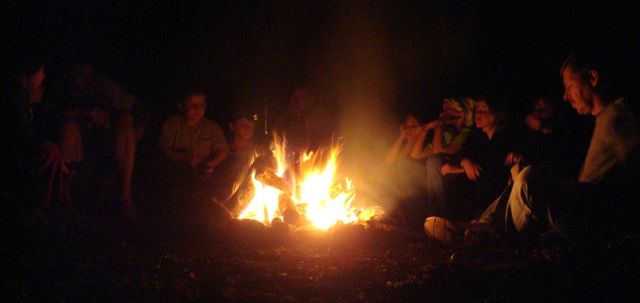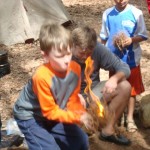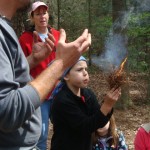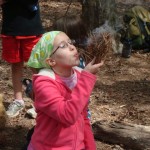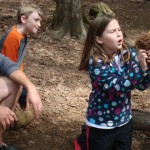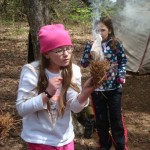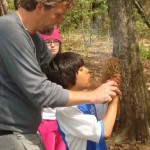I’d like to introduce you to Woods Wise Discovery – the new nature education and camping adventure created by me and Sure Foot’s newest guide, Tommy Tye.
The Woods Wise Discovery program provides an overnight field trip based on the adventure of a backpacking/camping trip and enriched with nature-based education.
A group of eight Upper-Elementary students, two parents, and one teacher participated in our recent Woods Wise Discovery program near the Chattooga River in north Georgia. The weather cooperated and we had a fabulous week in the woods.
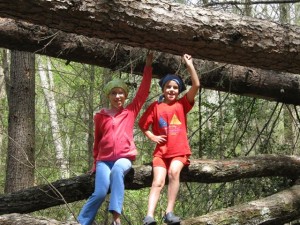 This three-day field trip was designed for the students to learn by doing. Tommy and I both subscribe to the belief that education is most effective when the teacher takes the “back door into learning.” Instead of introducing an academic subject, we teach by introducing a skill or a game and then present the academic aspects of this “fun” activity once the children are engaged. The kids soak up the information naturally without any need for “lecture” or “textbooks.”
This three-day field trip was designed for the students to learn by doing. Tommy and I both subscribe to the belief that education is most effective when the teacher takes the “back door into learning.” Instead of introducing an academic subject, we teach by introducing a skill or a game and then present the academic aspects of this “fun” activity once the children are engaged. The kids soak up the information naturally without any need for “lecture” or “textbooks.”
One example of this was during the first day of our adventure: It was lunch time and I fluttered about, trying to guide each child on the seemingly simple task of how to make a sandwich in the woods – using a sharp pocket knife to cut the meat, balancing the bread on your knee or resting it on a log while spreading your peanut butter on the other slice, using your spoon to scoop Nutella and then licking it clean. Though we successfully fed ourselves, I was pulled in all directions with questions and requests for help, and was wiped out afterwards, barely able to down my own sandwich.
One day two, however, I was able to say, “It’s lunchtime! You know how it works, so please get the lunch bags and prepare the meal.” And the kids did it without any help from me.
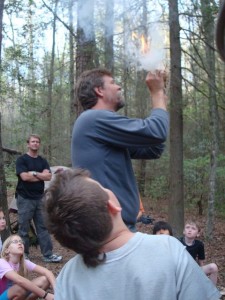
These children came into a totally new environment – with similarities to home, but significantly different – and were able to, after one “teaching” session, internalize the new systems and successfully complete tasks that formerly were anathema to them. I hope they can integrate this skill of learning-by-doing into their schoolwork and into their lives as they grow older.
Though the first day of any Woods Wise Discovery trip was focused on teaching camp skills and setting up our small village in the woods, Tommy’s programming was truly what made this trip so special.
On our first evening, Tommy showed us how to create fire by friction. The kids helped collect kindling and set up piles of sticks of increasing thickness. Tommy used his bow drill to produce an ember, placed that embered in a nest of tulip tree bark, and then used his breath and the kids’ kindling to feed the flames.
We had a great evening around our fire, roasting s’mores and telling stories!
I wish I could show you every activity that Tommy set up for the students. He taught about animals (and “tricked” us into stretching) by having us do Tai Chi inspired by wildlife, he helped us all practice hand-eye coordination through a Native 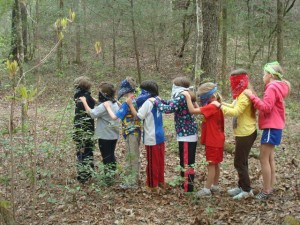 American stick-tossing game, and the students learned body control and attentive listening through “Fire Keeper” and teamwork in “Caterpillar” (pictured to the right). Tommy showed us plants that can be used for medicine and food. And we identified snakes, caught (and ate!) crayfish, and waded in water as much as possible.
American stick-tossing game, and the students learned body control and attentive listening through “Fire Keeper” and teamwork in “Caterpillar” (pictured to the right). Tommy showed us plants that can be used for medicine and food. And we identified snakes, caught (and ate!) crayfish, and waded in water as much as possible.
But the most fun activity for me to watch was Tommy’s lesson on fire. He asked the kids what is needed to make fire and they answered, “fuel, heat, and oxygen.” Then Tommy proceeded to explain each step of fire-making and demonstrated how to produce sparks using a flint stone and piece of steel.
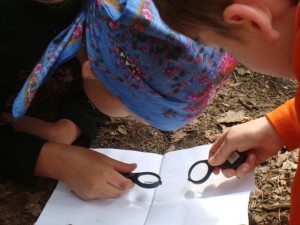 The students examined the sparks close up and Tommy taught them about heat by having them behave like molecules bouncing around as the temperature increased (I was jealous that I didn’t get to participate in that activity). Each student then built his or her own “nest” of pine straw and then created fire using the flint and steel. After the students were all successful in making fire, they even taught me and the two dads to do it. This was my first ever fire created without the use of matches or a lighter. I was incredibly impressed by these kids!
The students examined the sparks close up and Tommy taught them about heat by having them behave like molecules bouncing around as the temperature increased (I was jealous that I didn’t get to participate in that activity). Each student then built his or her own “nest” of pine straw and then created fire using the flint and steel. After the students were all successful in making fire, they even taught me and the two dads to do it. This was my first ever fire created without the use of matches or a lighter. I was incredibly impressed by these kids!
And I recommend you read Tommy’s list of academic connections that are covered in one lesson on fire (click here to read at the bottom of this post).
In the midst all of this learning, we also went to the sandy beach along the Chattooga River and played in water and sand. We waded at the base of Dicks Creek Falls, climbed the rocks beside the falls, and I helped the kids slide down a short (and safe) section of the falls.
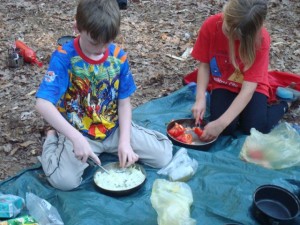 By the end of our three days, the kids were preparing meals with little help from me, purifying their water whenever they needed more, and they even packed up their backpacks like pros. It’s amazing what three days in the woods can accomplish!
By the end of our three days, the kids were preparing meals with little help from me, purifying their water whenever they needed more, and they even packed up their backpacks like pros. It’s amazing what three days in the woods can accomplish!
But before we left to go back to school, Tommy had one more lesson: shelter-building! Each pair of students built a debris shelter (using only dead sticks and leaves) for Tommy’s rubber duck. After 30 minutes of work, Tommy poured “rain” on each shelter – did the duck stay dry? In most cases, no. So the students put their heads together and worked as a team to build a debris shelter 10x bigger than any of the previous ones. The duck STILL got wet in the “rain!” So Tommy explained how large a debris shelter must be to truly protect you from the elements. The debris must be almost one meter thick!
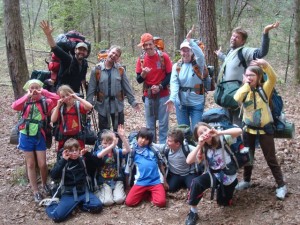 It left me excited to someday to build a debris shelter before a rainstorm and then try to sleep out with nothing but the clothes on my back. Would I stay dry and warm?
It left me excited to someday to build a debris shelter before a rainstorm and then try to sleep out with nothing but the clothes on my back. Would I stay dry and warm?
I hope you’ve had as much fun reading about this as I did getting to know this group of Fayette Montessori students. And I invite you to have Tommy and I lead a Woods Wise Discovery trip for your group!
Click here to view more of the photos from our trip.
And read Tommy’s academic connections for his fire building lessons below…
Here is one brief example of the potential academic connections and other benefits that we see in learning the simple earth skill of friction fire making:
- Natural history – Location and identification of appropriate plant materials
- Ecology – what grows where and why, how to find what you need, ecological significance of fire
- Social Studies – Ancestral skills and cultures from around the world, symbolism of fire, myths regarding fire
- Anthropology – Uses of fire, Significance/meaning of fire in human history, timeline of humanity, timeline of use of fire, timeline of control/creation of fire, variety of fire creation techniques
- Physics – wood properties for success, friction and heat, critical temperature, linear vs. rotary friction, pressure vs. speed, rotating spindle on string, durability and abrasion resistance, density, decay
- Math – 2 vs 3 dimensions, circles, rectangles, square edges, dividing circle into 3rds and 9ths
- Physical Education – form, technique, muscle memory, physical fitness, control of breathing, rhythm, tempo
- Critical thinking – trouble shooting and problem solving, attention to detail, patience, using the mind to control impatience in delicate moments (e.g. avoid crushing coal in excitement), using intuition over mind (don’t over analyze, trust the feel of the motion, go with the flow)
- Knife use and safety
- Cordage skills
- Knot tying
- Personal growth – resourcefulness, focus, perseverance, questioning, attention to detail
- Team building from 3-person bow-drill
- Team building from group fire (some gather tinder, some lay the fire, etc.)
- This can take the form of a competition between two groups
- Done appropriately, this can foster sportsmanship, fair play, and a sense of appropriate competition, in addition to positive group dynamics and working toward a group goal

